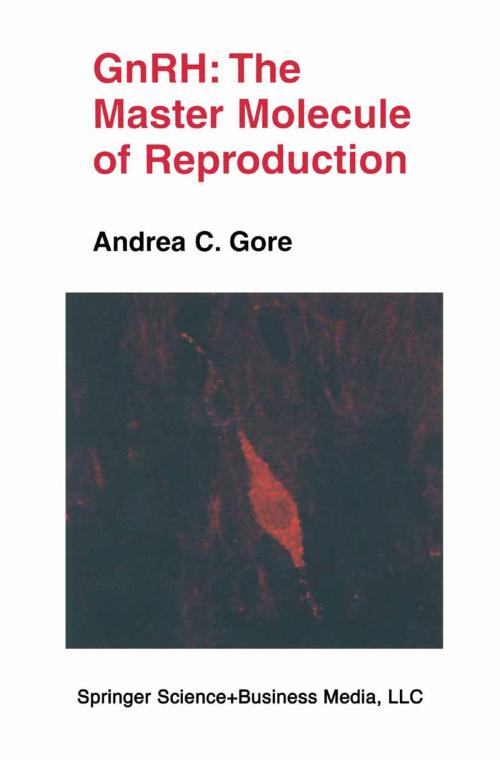GnRH: The Master Molecule of Reproduction
Nonfiction, Health & Well Being, Medical, Specialties, Internal Medicine, Neuroscience, Veterinary Medicine, Science & Nature, Science| Author: | Andrea C. Gore | ISBN: | 9781475735659 |
| Publisher: | Springer US | Publication: | March 9, 2013 |
| Imprint: | Springer | Language: | English |
| Author: | Andrea C. Gore |
| ISBN: | 9781475735659 |
| Publisher: | Springer US |
| Publication: | March 9, 2013 |
| Imprint: | Springer |
| Language: | English |
Gonadotropin-releasing hormone (GnRH) cells are the key regulators of reproductive function in all vertebrate organisms. The GnRH molecule is synthesized in a small number of neurons in rostral hypothalamic regions of the brain. In mammals, these neurons release the GnRH decapeptide into the portal capillary system leading to the anterior pituitary gland. There, GnRH causes the release of the gonadotropins, luteinizing hormone (LH) and follicle-stimulating hormone (FSH), which in turn act upon the gonads to stimulate their maturation, and to cause synthesis of sex steroid hormones, estrogen, progesterone and testosterone. Although each of the levels of the hypothalamic-pituitary-gonadal axis is critical for reproductive function, GnRH neurons play the primary role in the control of reproductive maturation and adult reproductive function, and may even play a role in reproductive senescence.
Since its discovery in 1970, there has been intense interest in GnRH-producing neurons, with more than 8000 papers and chapters in the last decade alone. Despite this activity of research in basic and clinical science, there has never been a book written specifically on GnRH neurons. GnRH: The Master Molecule of Reproduction aims to bring together the large and diverse literature of both laboratory and applied research that focuses on these unique cells.
This book will provide basic background into reproductive neuroendocrinology, as well as specifics regarding the role of GnRH neurons in the control of reproduction. Students studying endocrinology, reproduction, neuroendocrinology or molecular endocrinology will benefit from this book. In addition, this book will take a multi-species approach which will be useful both to basic researchers as well as clinicians. Whenever possible, species differences and similarities will be presented, and if possible, studies on humans, or the clinical relevance of basic research findings to humans will be discussed (such as the treatment of reproductive disorders such as abnormalities in pubertal development, or infertility).
Gonadotropin-releasing hormone (GnRH) cells are the key regulators of reproductive function in all vertebrate organisms. The GnRH molecule is synthesized in a small number of neurons in rostral hypothalamic regions of the brain. In mammals, these neurons release the GnRH decapeptide into the portal capillary system leading to the anterior pituitary gland. There, GnRH causes the release of the gonadotropins, luteinizing hormone (LH) and follicle-stimulating hormone (FSH), which in turn act upon the gonads to stimulate their maturation, and to cause synthesis of sex steroid hormones, estrogen, progesterone and testosterone. Although each of the levels of the hypothalamic-pituitary-gonadal axis is critical for reproductive function, GnRH neurons play the primary role in the control of reproductive maturation and adult reproductive function, and may even play a role in reproductive senescence.
Since its discovery in 1970, there has been intense interest in GnRH-producing neurons, with more than 8000 papers and chapters in the last decade alone. Despite this activity of research in basic and clinical science, there has never been a book written specifically on GnRH neurons. GnRH: The Master Molecule of Reproduction aims to bring together the large and diverse literature of both laboratory and applied research that focuses on these unique cells.
This book will provide basic background into reproductive neuroendocrinology, as well as specifics regarding the role of GnRH neurons in the control of reproduction. Students studying endocrinology, reproduction, neuroendocrinology or molecular endocrinology will benefit from this book. In addition, this book will take a multi-species approach which will be useful both to basic researchers as well as clinicians. Whenever possible, species differences and similarities will be presented, and if possible, studies on humans, or the clinical relevance of basic research findings to humans will be discussed (such as the treatment of reproductive disorders such as abnormalities in pubertal development, or infertility).















